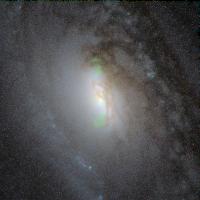
Host galaxies and nuclear structure of AGN with H2O megamasers as seen with HST
Heino Falcke1, Christian Henkel1, Andrew S. Wilson2,3, James A. Braatz4
1 Max-Planck-Institut für Radioastronomie, Auf dem Hügel 69, 53121 Bonn, Germany (hfalcke@mpifr-bonn.mpg.de)2Astronomy Department, University of Maryland, College Park, MD 20742-2421 (wilson@astro.umd.edu)
3Adjunct Astronomer, Space Telescope Science Institute
4National Radio Astronomy Observatory, P.O. Box 2, Green Bank, WV 24944 (jbraatz@nrao.edu)
in: ``QSO hosts and Their Environments'', Proceedings of a Workshop held in Granada, January 2001, Ed. I. Márquez Pérez et al., Kluwer Academic Press, p. 223-228
Abstract:
We present results of an HST survey in Halpha and continuum filters of a sample of H2O megamaser galaxies compiled by Braatz et al., all of which contain AGN. These observations allow us to study the AGN/host-galaxy connection, e.g. study the relation between the parsec scale masing disk/torus, bipolar outflows, and large scale properties of the galaxies such as dust lanes, signs for interaction, and galaxy types. A number of galaxies indeed show large-scale bi-polar Halpha structures which, however, are more reminiscent of outflows then excitation cones. Most megamaser galaxies are found in spiral galaxies. Only one galaxy in the original sample is known to be an elliptical and one galaxy imaged by us shows clear signs of interactions. In all cases we see evidence for obscuration of the nucleus (e.g. dust-lanes) in our color maps and the disk galaxies are preferentially edge on. This suggests that the nuclear masing disk has some relation to the large scale properties of the galaxy and the dust distribution.
Paper: Available in full length as PostScript and LaTex Format.
Other publications can be found here.
Questions: Heino Falcke, hfalcke@mpifr-bonn.mpg.de